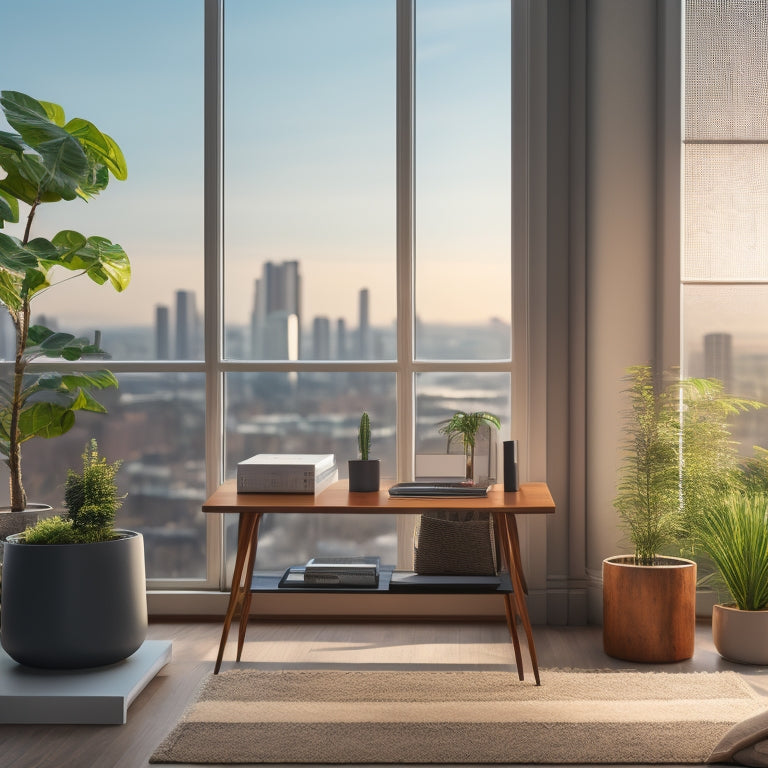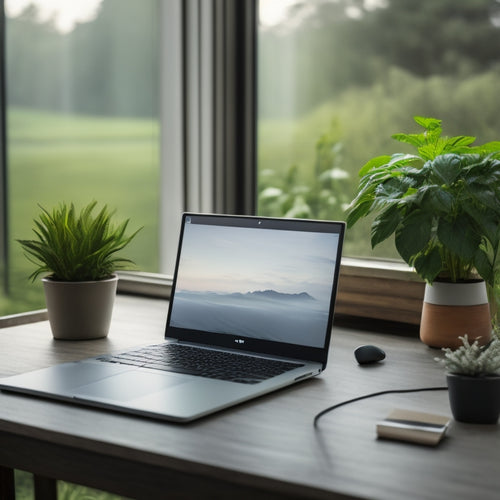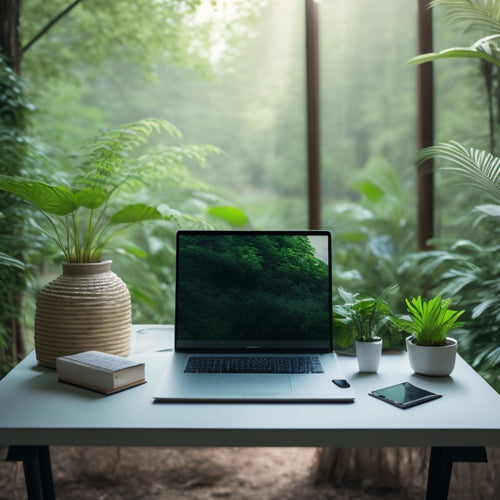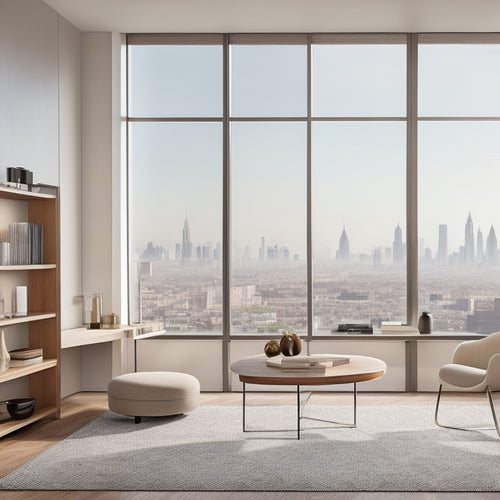
Effortless Home: Productivity Hacks for Every Room
Share
You're about to reveal the secret to altering your home into a productivity powerhouse, where every room is optimized to help you achieve your goals and enjoy a sense of calm and control. Start by decluttering and adopting a minimalist mindset to enhance focus and efficiency. Then, maximize storage in small spaces with vertical shelves and clever solutions. In the kitchen, streamline your workflow with meal prep routines and organized zones. From there, create a peaceful living room oasis with clean lines and calming colors. And, don't forget to tame the chaos of children's spaces with zones and chore charts. Now, uncover how to take your effortless home to the next level.
Key Takeaways
- Adopt a minimalist mindset to declutter and simplify storage in every room, maximizing productivity and focus.
- Optimize vertical space with shelves and storage units to create more room for essentials.
- Designate zones for specific tasks in each room, such as kitchen zones for prep, cooking, and cleanup, to streamline workflows.
- Implement productivity tools, like ergonomic workspaces and noise-cancelling headsets, to enhance efficiency and comfort.
- Use creative storage solutions, like bins and baskets, to maintain organization and structure in high-traffic areas like children's spaces.
Decluttering for a Fresh Start
Cluttered spaces can suffocate your productivity, making it difficult to focus on tasks and achieve your goals. To regain control, adopt a minimalist mindset and commit to a seasonal refresh.
By applying mindful decluttering techniques digital decluttering solutions, you can simplify storage and create functional systems that promote calmness. Start by clearing out items that no longer serve a purpose or bring you joy.
Sort items into categories, and be ruthless about letting go of duplicates or items that are no longer functional. Once you've purged your space, organize what's left into logical groups and assign a home for each item.
This will help you maintain your space and prevent clutter from building up again. By doing so, you'll create a sense of clarity and calm, allowing you to tackle tasks with renewed energy and focus.
Maximizing Storage in Small Spaces
You're likely no stranger to the frustration of feeling like your small space is bursting at the seams.
To combat this, you'll want to optimize your vertical space by installing shelves or storage units that go up to the ceiling.
Optimize Vertical Space
Release the full potential of your small spaces by optimizing vertical space. You'll be amazed at how much more storage you can squeeze out of your rooms.
Start by installing wall-mounted solutions like hanging organizers or pegboard displays. These will keep frequently used items within easy reach while keeping your floors and surfaces clear.
Consider vertical gardens or ladder shelves to add a touch of greenery or display decorative items. Don't forget about ceiling storage or high shelving for less frequently used items.
You can also employ over the door racks or suspended baskets to maximize the space around your doors.
Utilize Hidden Areas
Beyond the obvious storage solutions, there are often hidden areas in every room that can be repurposed to maximize storage in small spaces.
You can turn underutilized nooks into functional storage areas. For instance, consider installing under stair storage or hidden compartments in your staircase. This will provide a clever way to store items like linens, out-of-season clothes, or cleaning supplies.
Look for opportunities to repurpose dead space in your home, such as the area above your kitchen cabinets or the space beneath your bed.
Streamlining Your Kitchen Workflow
The kitchen is often considered the heart of the home, but it can quickly become a hub of chaos if not optimized for productivity.
To streamline your kitchen workflow, divide your kitchen into zones, each dedicated to a specific task, such as prep, cooking, and cleanup. This will help you move efficiently between tasks and reduce clutter.
Implement a meal prep routine to save time during the week. Designate a specific day and time for meal prep, and consider batch-cooking ingredients like rice, beans, or grains.
By doing so, you'll reduce kitchen stress and free up time for more important things.
With your kitchen zones and meal prep routine in place, you'll be cooking like a pro in no time.
Creating a Peaceful Living Room
You're now moving into the living room, where you'll focus on creating a peaceful atmosphere that promotes relaxation and calmness.
To achieve this, you'll need to design a space that's free from clutter, incorporates calming colors, and features cozy textiles that invite you to unwind.
Decluttered Space Designs
Design your living room to be a serene oasis by stripping away clutter and visual noise. To achieve this, adopt minimalist aesthetics that emphasize clean lines, simple shapes, and a limited color palette.
Invest in functional furniture that serves multiple purposes, like a storage ottoman or a sleek console table with built-in shelves. Streamline your decor by grouping similar items together and eliminating any unnecessary trinkets or knick-knacks.
Calming Color Schemes
About 60% of people say they feel more relaxed when surrounded by calming colors, and it's no surprise why. You can utilize the psychological effects of color psychology to create a peaceful living room.
Soothing palettes like light blue, pale green, and beige promote room harmony and mood enhancement. Consider the light influences in your space, as natural light can affect how colors are perceived.
To enhance space perception, use seasonal colors to create a sense of continuity. Accent contrasts can add visual interest, but be mindful of color shifts to avoid jarring effects.
Cozy Textile Choices
As you settle into your living room, the textiles that surround you can greatly impact your mood and sense of relaxation.
To create a cozy atmosphere, focus on incorporating a mix of textile textures, such as plush throw blankets, smooth velvet pillows, and soft rugs.
Fabric layering is also key; try combining lightweight curtains with heavier drapes to achieve a sense of depth and visual interest.
Consider the weight and warmth of your fabrics, too – chunky knits and faux fur can add a snug, wintery feel, while lightweight linens and cottons can create a cool, summery vibe.
Organizing Your Home Office Oasis
Your home office oasis should be a haven of productivity, not a source of stress. To achieve this, start by setting up an ergonomic setup that promotes comfort and reduces distractions.
Invest in productivity tools like a noise-cancelling headset or a paper tray organizer to keep your workspace tidy. Implement tech organization strategies like categorizing your computer files and using a task management app to prioritize your tasks.
Add personalized decor that sparks creative inspiration, such as a vision board or a motivational quote. Guarantee efficient lighting by positioning your desk near a natural light source or investing in a high-quality desk lamp.
Taming the Chaos of Children's Spaces
Establish a system of zones within your child's room to contain the chaos. Designate areas for playtime, homework, and relaxation.
Implement toy rotation to keep toys fresh and interesting, and create an art display to showcase their creations. Chore charts and playtime boundaries will help them develop a sense of responsibility.
Create sensory zones for exploration and reading nooks for quiet time. Involve your child in the process, encouraging family involvement and ownership.
Use creative storage solutions, such as bins and baskets, to keep clutter at bay. Add activity stations, like a craft table or building area, to encourage creativity.
Frequently Asked Questions
How Do I Maintain Motivation to Declutter and Organize My Home?
As you're sipping morning coffee, you glance around and suddenly feel overwhelmed by clutter. You think, "Today's the day I tackle this mess!" Set a timer, create a playlist, and plunge into decluttering strategies and organizing routines - you'll be motivated to maintain your newly found space in no time!
What Are Some Eco-Friendly Alternatives to Traditional Cleaning Products?
You're switching to eco-friendly cleaning! You're ditching harsh chemicals for natural cleaning methods and sustainable supplies. Try swapping paper towels for reusable cloths, and opt for refillable bottles with plant-based cleaning solutions that are gentle on surfaces and the planet.
Can I Still Be Productive While Watching TV or Listening to Music?
When you're burning the midnight oil, you can kill two birds with one stone by mastering multitasking techniques that let you stay productive while watching TV or listening to ambient sound, like podcasts or instrumental music.
How Often Should I Reorganize and Reassess My Living Spaces?
You should reassess your living space every 3-6 months, adjusting your reorganizing frequency based on seasonal changes, new habits, or shifting priorities, ensuring your space remains customized to your developing needs and goals.
Are There Any Productivity Hacks for People With ADHD or Disabilities?
You can adapt productivity hacks to suit your ADHD or disability needs by using visual cues, like color-coded labels, and incorporating sensory breaks, such as fidget toys or short walks, to stay focused and on track.
Related Posts
-

7 Best Ways to Declutter Your Digital Life
You're tired of drowning in digital clutter! To take control, start by purging unused subscriptions, and organizing y...
-

Clear Digital Clutter for a Peaceful Mind
You're tired of feeling anxious and mentally fatigued, but do you know that your cluttered digital space is a major c...
-

Streamline Your Space: Efficient Home Systems
You're already surrounded by the tools and spaces you need to live more efficiently, but they're being held back by c...


